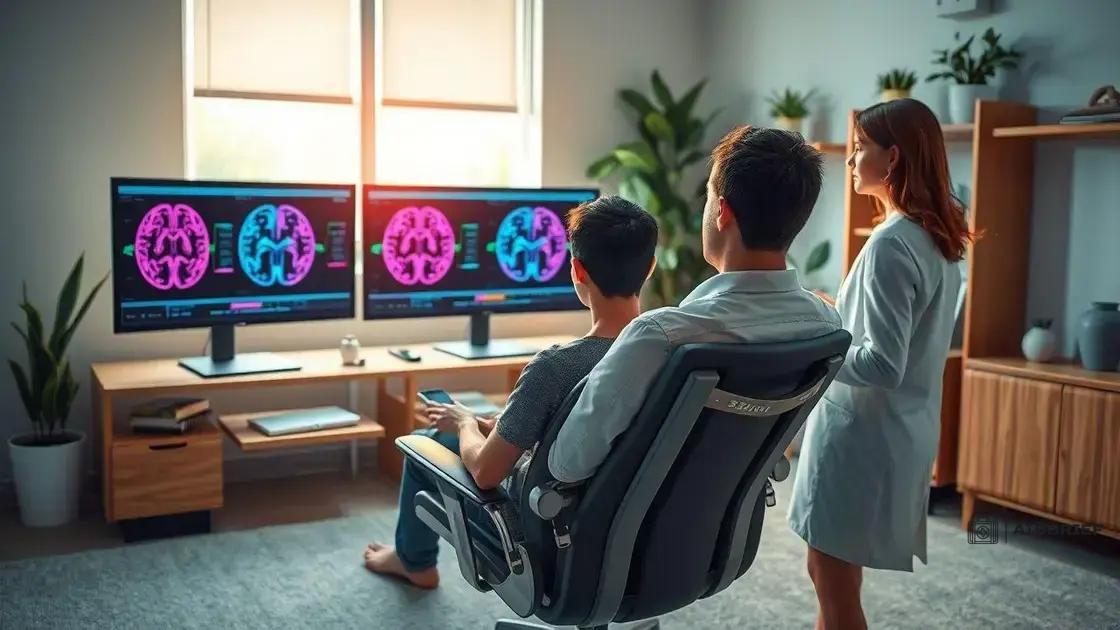Neurofeedback interventions supporting students with PTSD

Neurofeedback interventions supporting students with PTSD enhance emotional regulation, reduce anxiety, and improve academic performance, helping them manage their symptoms effectively.
Neurofeedback interventions supporting students with PTSD might be just what they need to overcome academic hurdles and emotional challenges. Have you ever wondered how technology can help heal minds and boost learning?
Understanding PTSD in students
Understanding PTSD in students is crucial for creating supportive learning environments. Many students face emotional and academic challenges due to traumatic experiences. Identifying these challenges can help teachers and parents provide better support.
What is PTSD?
Post-Traumatic Stress Disorder (PTSD) can occur after experiencing or witnessing a traumatic event. Symptoms may include flashbacks, anxiety, and emotional distress. Some students may withdraw from social interactions, struggle with focusing, or exhibit behavioral changes.
Common Symptoms in Students
Recognizing common symptoms of PTSD can help educators provide timely support. Students may display:
- Difficulty concentrating in class
- Frequent absences due to emotional distress
- Changes in mood or behavior
- Withdrawal from activities and peers
Addressing these symptoms early can prevent further academic issues. It’s important for teachers and staff to create a safe space for discussions about feelings.
Impact on Learning
PTSD can significantly impact a student’s learning capabilities. They may struggle with memory retention and classroom engagement. When a student’s mind is occupied with distress, their ability to focus on lessons is compromised. Understanding this helps in adjusting teaching methods to support PTSD-affected students.
Incorporating mindfulness practices and providing emotional support can make a difference. Encouraging open communication about feelings can also foster a sense of safety.
The role of neurofeedback
The role of neurofeedback in supporting students with PTSD is both innovative and essential. This technique uses real-time monitoring of brain activity to help students gain control over their emotional and cognitive processes. By learning to regulate their brain function, students can better manage the symptoms of PTSD.
Understanding Neurofeedback
Neurofeedback involves using EEG (electroencephalogram) technology that monitors brain waves. Students receive visual or auditory feedback that helps them learn how to change their brain activity. This process can be empowering, providing them with tools to address anxiety and stress.
How Neurofeedback Supports Students
There are several ways that neurofeedback can benefit students dealing with PTSD:
- Improvement in focus and concentration
- Reduction in anxiety and stress levels
- Enhanced emotional regulation
- Boosted resilience against triggers
As students engage in neurofeedback training, they may experience more stable emotional states. This newfound clarity can improve their learning environment and interactions with peers.
Implementing Neurofeedback in Schools
Schools can introduce neurofeedback programs as part of mental health initiatives. It’s important to provide training for staff on how to support students in this context. Collaboration between mental health professionals and educators can create a comprehensive approach to tackling PTSD.
Additionally, engaging families in the process can reinforce the benefits of neurofeedback at home, making it a holistic strategy for recovery.
Benefits of neurofeedback interventions

The benefits of neurofeedback interventions for students with PTSD are numerous and impactful. This approach not only addresses emotional issues but also enhances cognitive functions crucial for learning. By using real-time brain activity feedback, students can learn to regulate their emotions and improve their focus.
Emotional Regulation
One significant benefit of neurofeedback is improved emotional regulation. Students can develop skills to manage anxiety and stress effectively. By recognizing their brain patterns, they can learn techniques to overcome overwhelming feelings.
Academic Improvement
Another advantage is the potential for academic improvement. As students gain better control over their emotions, they often show increased concentration and engagement in their studies. This leads to:
- Improved grades and performance
- Enhanced memory retention
- Better participation in class discussions
- Reduced behavioral issues
With neurofeedback, students can experience a more positive classroom environment. They become more willing to tackle challenges and engage with their peers.
Stress Reduction
Furthermore, reduced stress levels are a key benefit of neurofeedback interventions. Many students with PTSD face chronic stress, impacting their daily lives. Neurofeedback training can help lower these stress levels over time, resulting in:
- Fewer headaches and physical complaints
- Better sleep quality
- Increased resilience against triggers
A calmer mind allows students to focus on learning rather than on their stressors. This shift can lead to an overall better quality of life.
How to implement neurofeedback
Implementing neurofeedback in schools involves a carefully planned approach that ensures both effectiveness and accessibility for students with PTSD. By integrating this innovative therapy into the educational setting, schools can provide essential support to help students overcome their challenges.
Steps for Implementation
To effectively implement neurofeedback interventions, schools should consider several key steps. First, it’s crucial to assess the specific needs of the students and understand the resources available. Establishing a comprehensive plan involves collaboration among educators, mental health professionals, and families.
Collaboration with Professionals
Engaging with qualified professionals who specialize in neurofeedback is vital. Schools should seek out experts who can train staff, ensuring that they are equipped to facilitate sessions. This training may include:
- Understanding brain function and EEG technology
- Learning how to interpret neurofeedback data
- Implementing strategies to support students during sessions
Having trained personnel in place helps in creating a safe environment for students to explore this therapy.
Creating a Supportive Environment
Establishing a supportive environment is also essential for success. This includes designing a dedicated space that is calming and free from distractions. Comfortable seating, appropriate lighting, and minimal noise can enhance the neurofeedback experience. Schools should also consider how to integrate these sessions into the daily schedule without overwhelming students.
Additionally, promoting awareness among other students and staff about neurofeedback can foster understanding and acceptance, reducing stigma around seeking help.
Monitoring Progress
Once implemented, it’s essential to monitor the effectiveness of the neurofeedback program. Regular assessments can help track student progress and identify areas that may need adjustment. Feedback from both students and parents can guide future sessions and improve outcomes.
By continuously refining the approach based on what works best, schools can maximize the benefits of neurofeedback for students dealing with PTSD.
Research and studies on effectiveness
Research on the effectiveness of neurofeedback interventions for students with PTSD is growing. Many studies indicate that these techniques can bring about significant improvements in emotional and academic performance. This demonstrates the potential for neurofeedback to transform the educational experience for affected students.
Key Studies and Findings
Several key studies highlight the positive effects of neurofeedback. For instance, a study published in a peer-reviewed journal found that students receiving neurofeedback training showed a marked decrease in anxiety levels. This anxiety reduction was linked to better concentration and improved learning outcomes.
Impact on PTSD Symptoms
Another important finding is how neurofeedback can help alleviate symptoms of PTSD in students. Research shows that through consistent neurofeedback sessions, students experience:
- Fewer occurrences of flashbacks
- Decreased hyperarousal
- Improved emotional stability
- Better coping strategies for dealing with trauma
These improvements not only aid students academically but also enhance their overall well-being.
Long-Term Benefits
In addition to short-term gains, research indicates potential long-term benefits of neurofeedback interventions. Students often demonstrate sustained emotional regulation skills even after completing the program. This can lead to better life outcomes, making them more resilient to future challenges.
Furthermore, a study assessing neurofeedback’s impact over a year revealed that many participants maintained academic improvements and reported increased self-confidence. This suggests that the benefits extend beyond the classroom and contribute to personal growth.
\n
| Topics | Details |
|---|---|
| 🌟 Emotional Regulation | Helps students manage emotions effectively. |
| 📚 Academic Improvement | Enhances focus and learning outcomes. |
| 💪 Stress Reduction | Lowers anxiety and improves mental health. |
| 🔍 Research Support | Studies validate its positive effects. |
| ⭐ Future Impact | Promises lasting improvements in well-being. |
\n
\n
FAQ – Frequently Asked Questions about Neurofeedback Interventions for Students with PTSD
What is neurofeedback?
Neurofeedback is a therapy technique that helps individuals learn to control their brain activity using real-time feedback from EEG monitoring.
How can neurofeedback help students with PTSD?
Neurofeedback can aid students by improving emotional regulation, reducing anxiety, and enhancing focus and learning outcomes.
Are there studies that support the effectiveness of neurofeedback?
Yes, several studies have shown that neurofeedback interventions can lead to significant reductions in PTSD symptoms and improvements in academic performance.
What steps are involved in implementing neurofeedback in schools?
To implement neurofeedback, schools should assess needs, collaborate with professionals, create supportive environments, and monitor student progress.





